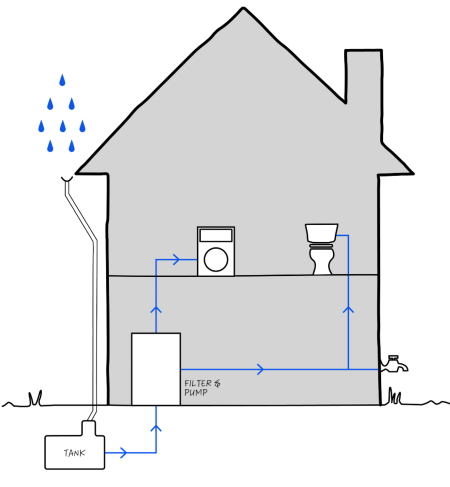Illustration of a rainwater harvesting system
Rainwater harvesting is the collection of rainwater from roofs or hardstandings for use for toilet flushing, laundry water supply, or irrigation.
Rainwater harvesting systems collect rainwater from your roof or other surfaces and store it for later use. The water is not to be used for drinking, cooking, or showering. Water is stored in over-ground tanks, often located in sheds, outhouses, or garages. If short on space the tanks can be stored underground. Filters and pumps are then used to provide water to the building or a tap nearby. Additional filters can be used to make the water suitable to drink, however these can be a more expensive add on.
Greywater recycling is the use of waste water from baths, showers and hand basins for toilet flushing, irrigation, or washing machine supply. The definition of greywater excludes sewage and also waste water from kitchen sinks.
Rainwater harvesting systems are easiest to fit when you are building a house or doing significant renovation as it will require changes to the plumbing system and potentially digging for water tank if stored underground.
Household rainwater systems reduce demand on drinking water supplies and decrease pressure on storm-water drains and sewers. Rainwater collected can be stored and used for garden use, car washing, toilet flushing, and washing machine use. Industrial pollution, contamination from bird droppings, and other dirt means that rainwater is rarely used for other uses.
We recommend using the UK Rainwater Management Association website for up-to-date price estimates of good quality domestic rainwater harvesting systems. The cost of running the pump is estimated to be very low. If you are on a water meter, it is estimated that the payback period for a rainwater harvesting system would be 10 to 15 years.
Use an online rainwater calculator to find out if it is worth looking at rainwater harvesting for your house.
An alternative cheap, or free, DIY option is to use water butts or buckets outside to collect and recycle water.
Listed Building Consent is required for rainwater harvesting systems and support will be given to sensitively detailed schemes.
Listed Building Consent is not required for using water butts or buckets to collect and recycle water.
For heritage assets, the alternative DIY rainwater harvesting option of simply using water butts or buckets to collect and recycle water is likely to be the most appropriate approach and does not require listed building consent.
We support the careful installation of rainwater harvesting systems by a suitably qualified professional where there is no detrimental impact on the special architectural or historic interest of the building.
In the light of the Climate Emergency, we will generally permit and encourage alterations on listed buildings, with special regard to the the following:
- Preserving the building, its setting or any features of special architectural or historic interest which it possesses
- Preserving or enhancing the character of a conservation area
- Respecting the significance of any non-designated heritage asset
The Environment Agency have produced an information guide on rainwater harvesting for domestic use

